The Role of the Left Arm Part II
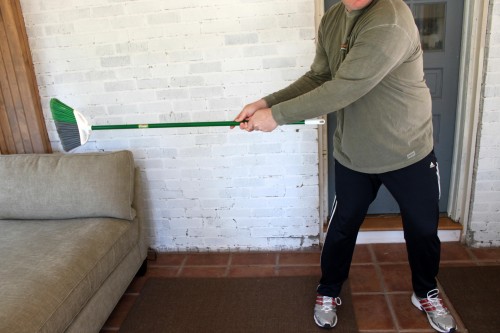
The Role of the Left Arm Part II
In The Role of the Left Arm Part 1, I wrote about Jimmy Ballard’s well-established idea of “connection” in the golf swing. I was recently reviewing an older tape of Jimmy’s teaching, and I got a better grasp of another important left arm concept – Jimmy calls it a “shorter” left arm, or “half a left arm.” This begs the question:
Should your left arm remain stiff throughout the swing?
This is a common mis-conception so lets take a look at one particular case, specifically, Calvin Peete, who led the tour in ball striking for nearly 10 years, and who literally could not straighten his left elbow. You can see Jim McLean describing this here:
Moveover, if you look at setup photos of Nicklaus, Hogan, Sneed and Jones, their arms are ‘soft’ at address, not stiff or straight, forming a triangle where the left hand is shorter, on what Jimmy calls the ‘inner rail’ of the swing, and the right hand is longer on the ‘outer rail.’ This ‘shorter’ left arm allows the shoulders to be more level, the posture to be more square and less dip of the right shoulder at address. Here is a video of Hogan demonstrating the soft arms on the Ed Sullivan show:
In the below pictures, I’ve demonstrated with a broom to make the club face’s position more evident at each position of the swing, how the triangle, formed by your arms and chest, stays intact. You can do this with a traditional grip, or split-grip drill (separate your hands by a few inches to better feel the “shorter” left and “longer” right hand on the grip).
Here are positions that I practice, and you can see what I’m talking about in this address photo:
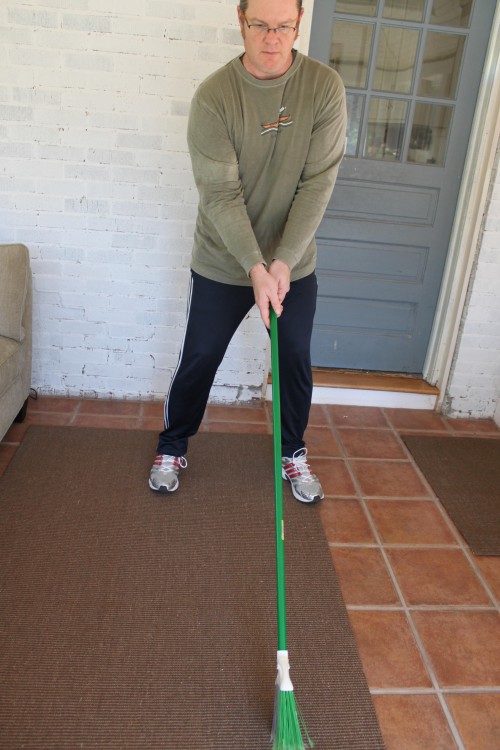
Both arms are soft at address

At waist high going back, the triangle is intact with the left hand still on the ‘inner rail’ and the right hand on the ‘outer rail.’
;
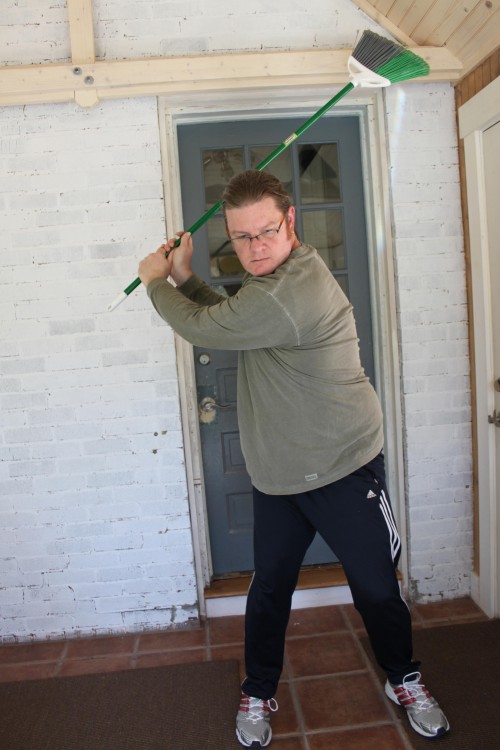
From this position, as my shoulders finish turning back, or Jimmy would say ‘coiling’ by having my right arm simply fold, and move up to the throwing position in football or baseball.
The downswing is initiated from the ground up, ie, by my pushing off the inside of the right toe. With this initial move, my right hip leads the way and allows me to release my right arm and hand down the target line, and throw as hard as I want with my right hand. Another way to think about it is, the lower body starts the swing and the arms and shoulders follow.
You will notice that I have not included a picture at impact. I have omitted that section of the swing because of the advice I got from Jim Colbert who would constantly remind me to focus simply on swinging through to a correct balanced finish rather than thinking about a specific impact position, or rather to swing the club and ‘let the ball get in the way.’
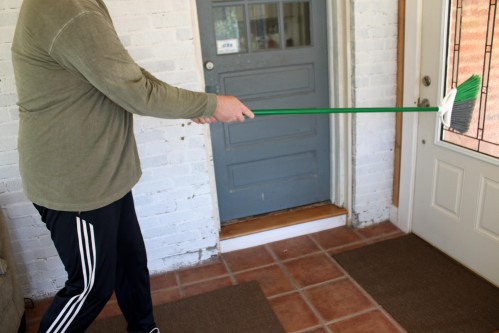
At waist high past impact you can see where the left arm is still soft and short and the right arm is long and extended down the target line.
You will notice by the postion of the broom or ‘clubface’ during the swing, I have not had to manipulate my hands, or rotate my forearms at all to keep the club head square and in the center of the triangle for the entire swing. If you can do this with a soft and ‘shorter’ left arm, you’ll be amazed how easily you can square the club face and hit the straightest balls of your life.
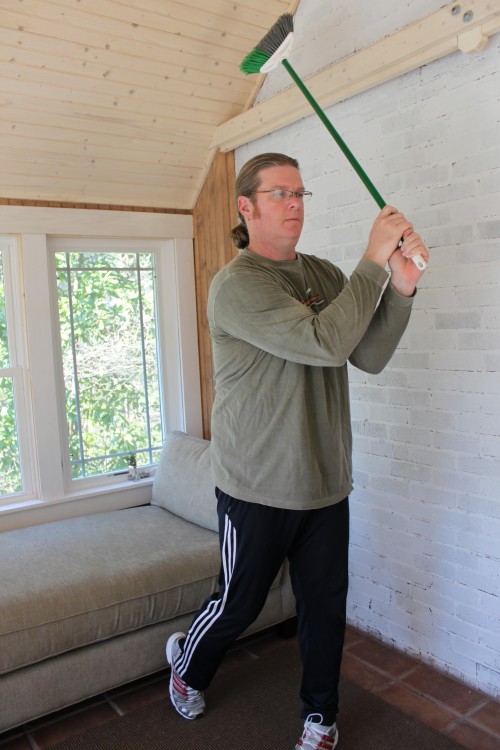
- From there, my left arm folds and I am in my fully-balanced position for the finish.
While there are pros who do keep a straight left arm it can be difficult to manage and there are plenty of big time names who go with a softer feel including Hal Sutton, Annika Sorenstam, Rocco Mediate, Curtis Strange, Jim Colbert, Peter Jacobsen and Jim Dent to name a few. Next time you are at the range try a softer left arm and let me know what you think.



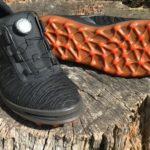
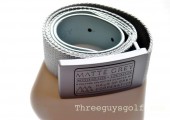

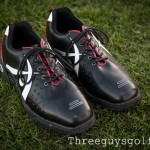

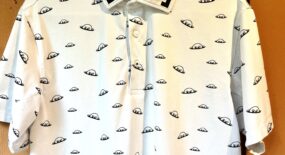

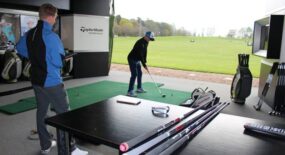
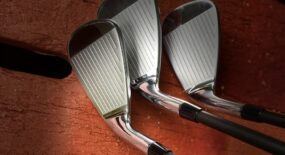
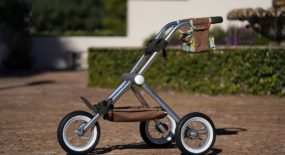


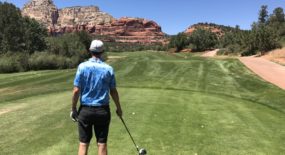
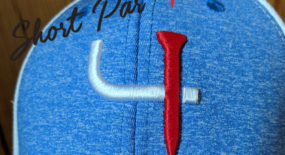
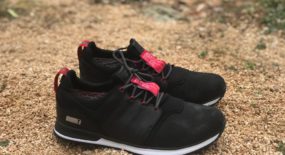
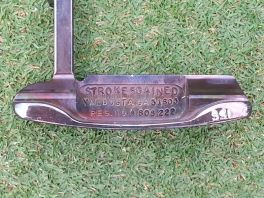
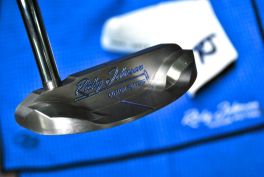
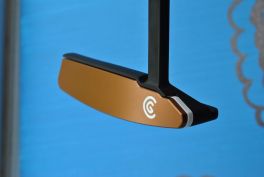
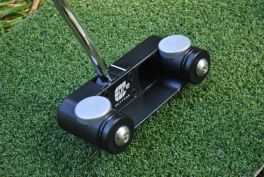
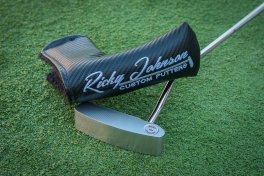
Wow, did not know that about Calvin Peete. This makes total sense to me, gonna try it out, I think I always have a pretty straight left arm and perhaps it’s a little too much, I like how the softer arm locks in the proper release of hands, although I’m sure I’ll screw it up somehow! Thanks for the tip. TV was kinda boring back then, huh?
Thanks for taking the time to comment. I hope that you are able to find some help with this idea, and that you’ll also let us know how it goes!
Your shoulder plane is very flat (horizontal).
The worst thing about actively keeping your left arm perfectly straight throughout the entire swing is that it’s hard not to develop tension in your arm, shoulder, etc. and end up not being able to “feel” the rhythm of the swing, and start actively pushing the club around instead of passively following it. That being said, if you can get that left arm bone straight at impact, you’ll pick up 20 yards on your irons, and more on the driver. It makes a big difference.
Look at Rory. he locks up that left elbow and throws away the key.
See, this is the kind of drivel you get when you post about swing concepts…. sorry
Hey Ed, Thanks for the comment. I don’t think it’s drivel, and I’m glad for the conversation. I”m not saying that this is the only way to swing, but the easiest to equate with other right-handed motions like skipping a rock, or hitting a baseball or tennis ball. My shoulders are meant to be very horizontal in this swing, and the swing moves more up and down, and doesn’t get behind me (usually).
As for the left arm at impact, I agree with you, but not because I’ve tried to straighten it, but in the ‘throwing’ down the line, the arms are pulled to their extended length down the line; I”m also keeping it soft to allow it to start folding past impact to really let the toe release and the right arm extend down the target line. And as for distance, this swing was Jim Dent’s swing and he lead the Champions Tour in driving distance for many years, and you don’t have to fear the snap hook.
And here’s a breakdown of Annika’s swing that really shows how tall she stands, how her shoulder turn is very horizontal or parallel with the ground, no dipping and soft arms, that look very much like Hogan. the straightness of the left arm is flexibility that I don’t have, not tension : )
http://progolferdigest.com/swing-tips/annika-sorenstams-swing-the-stand-up-swing/
I enjoyed reading your post! Great pics too! I’m sending a link to my dad who is an avid golfer…he’ll be excited to know of this blog. Thanks!
I love how Hogan says “Isn’t that simple? Anyone can do that”.
In the connected swing,why do I ever hit it fat? Is it disconnected or being too ball bound? Do I need to stand taller? Really hitting my driver well, just don’t understand my occasionally hitting it fat! love your posts!! Any drills would be awesome